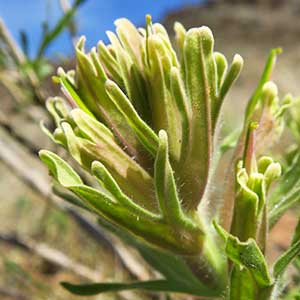Castilleja viscidula
Castilleja xanthotricha
sticky Indian paintbrush, sticky paintbrush
John Day or yellow-hairy paintbrush, John Day paintbrush, yellow hair paintbrush, yellow-hair Indian paintbrush
several, ascending to erect, decumbent at base, unbranched, sometimes branched, hairs spreading, long, soft, mixed with shorter stipitate-glandular ones.
few to several, ± decumbent to erect or ascending, unbranched, sometimes with short, leafy axillary shoots, hairs erect to spreading, long, soft, eglandular, mixed with short stipitate-glandular ones.
green to brown, linear, linear-lanceolate, lanceolate, or oblong (narrowly ovate nearing inflorescence), 1–4(–5) cm, not fleshy, margins wavy, flat or involute, (0–)2(–5)-lobed, apex acute;
lobes ascending-spreading, oblong to narrowly lanceolate, apex acute or obtuse.
green, linear, lanceolate to broadly lanceolate, oblong, or cuneate, 0.8–5 cm, not fleshy, margins plane to wavy, involute, 0–5-lobed, apex acute, sometimes rounded;
lobes spreading, linear, arising below mid length, nearly as broad as center lobe, apex acute.
2–14 × 1–3.5 cm;
bracts proximally greenish to greenish brown, distally pale yellow, cream, or yellow-green, sometimes yellow-orange or red (sometimes gradually differentiated from proximal coloration), lanceolate, broadly lanceolate, or oblong, 3(–5)-lobed, proximal wavy-margined;
lobes ascending, linear to narrowly lanceolate, long, arising near or above mid length, sometimes wavy-margined, apex acute to rounded.
3–14 × 1.5–4.5 cm;
bracts proximally greenish, rarely dull reddish purple, distally white to cream, rarely pale yellow or dull, pale pink (sharply differentiated from proximal coloration), lanceolate or oblong to narrowly ovate, (3–)5–7-lobed;
lobes ascending, linear to obovate, ± broadened distally, medium, long, proximal lobes arising below mid length, central lobe apex broadly rounded to truncate, others acute to rounded.
straight, 16–22(–25) mm;
tube 10–15 mm;
beak exserted, straight to sometimes curved, adaxially green to yellow, 5–8(–9) mm;
abaxial lip green or yellow, sometimes deep purple, reduced, inconspicuous, often visible in abaxial cleft, 1–2 mm, 20% as long as beak;
teeth erect, green to white, sometimes yellow or pink, 0.5–1 mm.
curved, 17–23 mm;
tube 15–19 mm;
beak exserted, adaxially green, 5–8(–9) mm, puberulent, stipitate-glandular;
abaxial lip deep purple (color sometimes visible through calyx), green, pinkish, or pale yellow, ± prominent, slightly inflated, usually hidden in calyx, sometimes right at top of calyx, 2 mm, ca. 50% as long as beak;
teeth ascending, whitish, yellowish, pink, or green, 1–1.5 mm.
colored as bracts or proximally paler, (10–)14–18 mm;
abaxial and adaxial clefts (4–)5–9 mm, 30–40% of calyx length, deeper than laterals, lateral (1–)2–6 mm, ca. 25% of calyx length;
lobes narrowly ovate to lanceolate, linear, or narrowly lanceolate, apex acute to obtuse.
colored as bracts, 15–26 mm;
abaxial and adaxial clefts 3.5–7 mm, 25–50% of calyx length, deeper than laterals, lateral 2–5 mm, 12–25% of calyx length;
lobes linear, oblong, or narrowly triangular, center lobe apex usually rounded, lobes acute to rounded.
= 24, 72.
= 48.
Castilleja viscidula
Castilleja xanthotricha
Castilleja viscidula is a member of the complex including C. applegatei and C. martini, centered in California. Castilleja viscidula favors isolated mountain ranges, from the Wallowa and, possibly, the Blue mountains of northeastern Oregon, eastward into southwestern Idaho, and southward into central Nevada. Most populations are greenish yellow, but in one portion of the Wallowa Mountains, reddish bracted plants are common. Many yellowish bracted populations in the same mountain range surround this reddish population. Intermediate color forms are rarely encountered. Most ranges where C. viscidula occurs have generated slightly differing local races, demonstrating some reproductive isolation and divergence. In addition, hybrid swarms between this species and C. nana are known from several mountain ranges in central and northern Nevada, and an apparent hybrid with C. flava var. flava is known from the Independence Mountains of northern Nevada.
(Discussion copyrighted by Flora of North America; reprinted with permission.)
Castilleja xanthotricha is endemic to moderate elevations in the sagebrush hills of the John Day River drainage in north-central Oregon. N. H. Holmgren (1971) hypothesized that this tetraploid species is of allopolyploid hybrid origin between C. glandulifera and C. oresbia.
(Discussion copyrighted by Flora of North America; reprinted with permission.)


